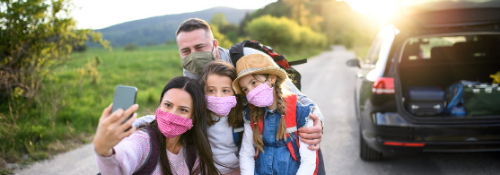
It has been almost two years since the COVID-19 pandemic turned our lives upside-down. We have navigated surges and lulls in cases. But the constant uncertainty is beginning to take a toll. As the recent Omicron-driven surge in cases begins to slow, we find ourselves in what has become an increasingly familiar position. We have to decide how and when we return to our "normal" routines and activities.
“We are all adjusting to the unknown. Just remind yourself that there are things you can do to maximize safety, like wearing a mask and social distancing.”
So how do we navigate this transition? Mental health experts say it begins with realizing that everyone will experience this transition differently and have varying levels of comfort in resuming certain activities.
“Don’t assume everyone is in the same place,” says Dereck Dean, Senior Director of Clinical and Specialty Services at PACES. “And don’t take it personal. This isn’t about whether someone loves you. It’s about safety. Assume good intentions and be respectful of boundaries.”
Adjusting to the Unknown
When it comes to navigating this return to normal routines and activities, it’s important to remember that it is normal to feel a little anxious.
“We are all adjusting to the unknown,” says Phil Bohlander, Outpatient Therapist at Wyandot Center. “Just remind yourself that there are things you can do to maximize safety, like wearing a mask and social distancing.”
Bohlander also points out that there is an important distinction between fear and worry. While fear can help to protect us from dangerous situations, worry focuses on things that haven’t happened yet. One way to help manage your emotions is to evaluate your self-talk.
“If you find yourself always thinking ‘something bad is going to happen. I’m going to get sick’ you need to put those thoughts out of your mind,” says Bohlander. “We might not be sure when COVID-19 will be under control, but it will happen someday.”
While there isn’t a one-size-fits-all solution to our current situation, there are some things we can do to make this transition a little easier to handle. One key to success is tapping into your social supports to combat the effects of isolation.
“Our strength comes from being in groups,” says Bohlander. “How many friends have you called this week? Just talk and make those connections. When we do that, our social supports will show us we’ll be ok together.”
Bohlander also stresses the importance of laughter.
“Look for things that are funny. You find what you look for. Laughter is a shot in the arm. That’s my medicine.”
Guiding Children Through this Transition
COVID-19 was very disruptive for children and teenagers, as well as adults. Younger people had no way to prepare for how the pandemic would affect their lives. When schools closed in 2020, kids lost their social connection and their sense of community. And that social connection was not easily replaced, due to social distancing restrictions. Dean says as children resume their pre-pandemic activities, it is very normal for them to feel a little anxious.
“Give them time to ramble and rummage through their emotions. It might not be orderly and chronological, but it’s still very important. Kids need to know what they feel. For many kids, that’s how they process is by talking.”
“When kids have apprehension about the future and going back to school… what does that look like? Will my friends be there? Will I be able to hug my teacher? Can I play with my friends? Those are some of those standard questions.”
But Dean says if you begin to notice obsessive behaviors that interfere with daily functioning, that might be a sign that something else is going on and you should seek professional help. This can include changes to sleeping or eating patterns, excessive crying and avoidance behaviors.
As parents help their children through this transition, Dean says it is important for parents not to assume that they know what their child is feeling. Instead, ask open-ended questions, listen nonjudgmentally and help your children identify what they are feeling.
“Give them time to ramble and rummage through their emotions,” says Dean. “It might not be orderly and chronological, but it’s still very important. Kids need to know what they feel. For many kids, that’s how they process is by talking.”
Trauma Responses from COVID-19 Pandemic
COVID-19 has affected all of us in some way, whether that it is in terms of health, finances, safety or social connection. The pandemic has been traumatic for many people and trauma responses can vary widely. While some individuals have felt the full weight of the pandemic over the past two years, others have been able to preoccupy themselves with the tasks necessary to keep themselves and their families afloat. As we begin to settle back into our pre-pandemic routines, the gravity of all we’ve experienced since 2020 can hit us unexpectedly.
“When tasks are taken away and there’s nothing else to occupy your mind, that’s when you’re left to deal with those emotions that you didn’t have time to deal with when you had so many things to do,” says Dean. “It’s normal to get down the road and then be feeling something you didn’t feel before because you didn’t have time to grieve.”
As we navigate this transition back to pre-pandemic life, be sure to check in with yourself regularly and make time for self-care. Go at your own pace and take the necessary precautions to keep yourself and those around you safe and healthy – both mentally and physically.
If you need support, please reach out. For adults, please call 913-328-4600 weekdays between 8 a.m. and 5 p.m. to make an appointment. For children and families, please call 913-563-6500 weekdays between 8 a.m. and 5 p.m. to schedule an initial appointment. For immediate help in a crisis, please call our 24/7 crisis line at 913-788-4200.
